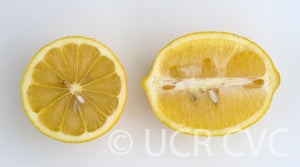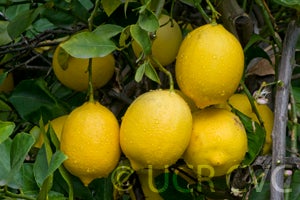Citrus limon L. Burm.f.
CRC 3593
PI 230373
VI 667
Source
Received as budwood from Dr. Joe Furr, USDCS, Indio, Calif., 1965.
Parentage/origins
Interdonato is considered a lemon-citron hybrid and is said to have originated about 1875 on the property of a Colonel Interdonato in Nizza, Sicily.
Rootstocks of accession
Yuma Ponderosa lemon
Season of ripeness at Riverside
Crop produced mainly in fall and early winter.
Notes and observations
12/2/1987, EMN: Fruit examined- a market type lemon.
Description from The Citrus Industry Vol. 1 (1967)
" Fruit large, oblong-cylindrical; collared or short-necked; truncate at apex; prominent sharp-pointed conical nipple surrounded by pronounced areolar furrow, commonly deeper on one side; seeds very few. Color yellow at maturity. Rind thin, very smooth, shining; tightly adherent. Segments 8 to 9; axis medium-small and solid. Flesh color greenish-yellow; crisp and juicy; flavor highly acid with slight bitterness. Crop produced mainly in fall and early winter. Earliest of Italian varieties.
Tree vigorous, upright-spreading, usually thornless; foliage moderately dense. Leaves large and somewhat citron-like, with round-pointed blades, undulate margins, and short wingless petioles. Moderately productive but does not respond well to forcing treatment and hence grown primarily for early fruit.
According to Burke (1962), the very distinctive Interdonato variety, which currently accounts for about 5 per cent of Italian production, has been planted solely because of its resistance to mal secco disease, to which its resistance is said to be intermediate between the Femminello and Monachello varieties.
Interdonato is considered a lemon-citron hybrid and is said to have originated about 1875 on the property of a Colonel Interdonato in Nizza, Sicily."
Availability
Commercially available in California through the Citrus Clonal Protection Program. Click here to order budwood.
USDA Germplasm Resources Information Network page for Interdonato lemon


